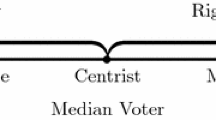Abstract
In this article, a two-party contest where candidates allocate their campaign resources strategically between two salient issues is studied. The analysis aims to determine the circumstances under which there is issue convergence (both parties emphasizing the same issue) or issue divergence (different parties emphasizing different issues) during a political campaign. For this purpose, the concepts of a party’s absolute and comparative advantage are used. A party has an absolute advantage on an issue if a majority of voters prefer its position on this issue to that of its opponent. A party has a comparative advantage on an issue if the percentage of votes that it would obtain if voters cared only about that issue is larger than those that it would obtain if voters cared only about the other issue. It is shown here that issue convergence can occur only if one of the parties has an absolute advantage on both issues, but its comparative advantage is not too large. Otherwise, there will be issue divergence in the political campaign.
Similar content being viewed by others
References
Amorós, P., & Puy, M. S. (2010). Indicators of electoral victory. Public Choice, 141, 239–251.
Ashworth, S., & Bueno de Mesquita, E. (2009). Elections with platform and valence competition. Games and Economic Behavior, 67, 191–216.
Austen-Smith, D. (1993). Information acquisition and orthogonal argument. In W. A. Barnett, M. J. Hinich & N. J. Schofield (Eds.), Political economy: institutions, competition, and representation (pp. 407–436). New York: Cambridge University Press.
Baron, D. P. (1994). Electoral competition with informed and uninformed voters. American Political Science Review, 88, 33–47.
Besley, T., & Coate, S. (1997). An economic model of representative democracy. Quarterly Journal of Economics, 112, 85–114.
Gemenis, K., & Dinas, E. (2010). Confrontation still? Examining parties’ policy positions in Greece. Comparative European Politics, 8, 179–201.
Glicksberg, I. L. (1952). A further generalization of the Kakutani fixed point theorem with application to Nash equilibrium points. Proceedings of the National Academy of Sciences, 38, 170–174.
Grossman, G. M., & Helpman, E. (1996). Electoral competition and special interest politics. Review of Economic Studies, 63, 265–286.
Harrington, J. E. Jr., & Hess, G. D. (1996). A spatial theory of positive and negative campaigning. Games and Economic Behavior, 17, 209–229.
Herrera, H., Levine, D. K., & Martinelli, C. (2008). Policy platforms, campaign spending and voter participation. Journal of Public Economics, 92, 501–513.
Iyengar, S., & Kinder, D. (1987). News that matters. Chicago: University of Chicago Press.
Iyengar, S., & Simon, A. F. (1993). News coverage of the Gulf crisis and public opinion: a study of agenda setting, priming and framing. Communication Research, 20, 365–383.
Jerit, J. (2008). Issue framing and engagement: rhetorical strategy in public-policy debates. Political Behavior, 30, 1–24.
Kaplan, N., Park, D. K., & Ridout, T. N. (2006). Dialogue in American political campaigns? An examination of issue convergence in candidate television advertising. American Journal of Political Science, 50, 724–736.
Krosnick, J. A., & Kinder, D. R. (1990). Altering the foundations of support for the President through priming. American Political Science Review, 84, 497–512.
Osborne, M. J., & Slivinski, A. (1996). A model of political competition with citizen-candidates. Quarterly Journal of Economics, 111, 65–96.
Page, B. I. (1976). The theory of political ambiguity. American Political Science Review, 70, 742–752.
Petrocik, J. R. (1996). Issue ownership in presidential elections, with a 1980 case study. American Journal of Political Science, 40, 825–850.
Poole, K. T., & Rosenthal, H. (1991). Patterns of congressional voting. American Journal of Political Science, 35, 228–278.
Prat, A. (2002). Campaign spending with office-seeking politicians, rational voters, and multiple lobbies. Journal of Economic Theory, 103, 162–189.
Riker, W. H. (1993). Rhetorical interaction in the ratification campaign. In W. H. Riker (Ed.), Agenda formation (pp. 81–123). Ann Arbor: University of Michigan Press.
Sagarzazu, I. (2011). Weak party institutionalization and the dynamics of political dialogue. Nuffield College Working Papers in Politics 2011-3.
Sigelman, L., & Buell, E. (2004). Avoidance or engagement? Issue convergence in Presidential campaigns. American Journal of Political Science, 48, 650–661.
Simon, A. F. (2002). The winning message: candidate behavior, campaign discourse, and democracy. Cambridge: Cambridge University Press.
Spillotes, C. J., & Vavreck, L. (2002). Campaign advertising partisan convergence or divergence. Journal of Politics, 64, 249–261.
Vavreck, L. (2009). The message matters. The economy and presidential campaigns. Princeton: Princeton University Press.
West, D. (2000). Air wars: television advertising in election campaigns, 1952–2000. Washington: CQ Press.
Westermark, A. (2004). Extremism, campaigning and ambiguity. Games and Economic Behavior, 47, 421–452.
Wlezien, C. (1995). The public as thermostat: dynamics of preferences for spending. American Journal of Political Science, 39, 981–1000.
Author information
Authors and Affiliations
Corresponding author
Rights and permissions
About this article
Cite this article
Amorós, P., Puy, M.S. Issue convergence or issue divergence in a political campaign?. Public Choice 155, 355–371 (2013). https://doi.org/10.1007/s11127-011-9865-0
Received:
Accepted:
Published:
Issue Date:
DOI: https://doi.org/10.1007/s11127-011-9865-0




